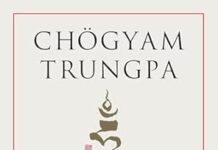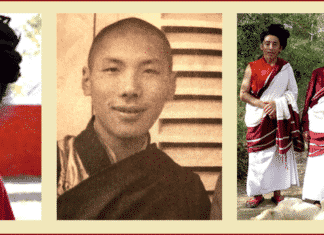My experience of Yangsi Rinpoche’s “weekend in Ward” began earlier in the week, with a tea and rice ceremony inviting him to the Boulder Shambhala Center. An unusual degree of electricity pervaded the shrine room air as we awaited his arrival. As the rebirth of His Holiness Dilgo Khyentse Rinpoche, arguably the greatest lama of the final generation to come out of Tibet before the Chinese takeover, Yangsi Rinpoche has to fill the largest possible shoes. Khyentse Rinpoche, a primary teacher of Trungpa Rinpoche, had enormous impact on the Vajradhatu/Shambhala sangha when he visited here in the 70’s and 80’s. His unique, vast as outer space authentic presence remains burned into my own memory.
So when the much shorter Yangsi Rinpoche, all of 17 years old, came into the shrine room, we witnessed a kind of scene special to Tibetan Buddhism, where the buddha activity of the previous teacher becomes identified with another, subsequent person, who at the same time must undergo rigorous training to sit on that very high throne. But there he was, identified with the grand, cosmic old man we knew, receiving our prostrations. Then came what became established through the next few days as a primary ceremonial pattern. He was given a long form, elaborate mandala offering, then an even more elaborate series of testimonials, extolling the marvelous virtues of his predecessor, praising his own qualities, and thanking him profusely for coming. When his own time came, he spoke only for a couple of minutes, though it was enough to establish some qualities: humble, low key, understated.
Then it was over.
I walked out feeling good. Something had happened in that atmosphere, though hard to say what.
I attended as well the longevity empowerment Yangsi Rinpoche conducted in the Boulder Theater Friday evening. Again we witnessed extensive praise and gratitude for Rinpoche’s visit here, followed by the empowerment ritual during which he offered to us just a few comments, the only one which sticks in my mind being his disavowal that he’d practiced this particular text so that he was violating protocol by giving its empowerment. But give it he did. I was sitting in the back row of the balcony, so that when the blessing line finally and very slowly started to wind across the stage, it became quite a jovial atmosphere for chitchat with old sangha friends who’d come out of the woodwork to attend.
The following morning, I rose at 5:30 in order to pick up my friends Duncan and Simba and drive us up to Ward under a lovely blue sky. Mangala Shri Bhuti, Dzigar Kongtrul Rinpoche’s meditation center, sits on the edge of a ridge, looking steeply down into a valley on one side, and rolling out to a meadow with high peaks in the distance to the other. Very much the lha realm. A stone platform with a tent erected over it provided the shrine space. This was clearly Mangala Shri Bhuti’s first really big event; they’d been preparing for two entire years, no doubt overworking their coterie of volunteers. You could feel their thoughtfulness and care in everything they did, from the people parking cars to the dining tents in the meadow with coffee, tea, muffins, and fruit, to the eight auspicious symbols drawn on the road for Rinpoche’s car to roll in upon.
Saturday morning, after a formal parade entrance and the usual offerings and homage, Rabjam Rinpoche, Khyentse Rinpoche’s dharma heir, and primary teacher to Yangsi Rinpoche, spent a good hour telling us anecdotes about Khyentse Rinpoche, full of luminosity and humor. He spoke particularly at the end about how anything connected with Khyentse Rinpoche’s blessings had a kind of effortless auspiciousness, describing, for example, how his need to inform personally a number of different lamas and dignitaries that Khyentse Rinpoche’s reincarnation had been found led him to running spontaneously into one person after the next. One had the feeling he could sit there and tell stories for the next two weeks and no one would have tired of it.
Then, really for the only time, we got to hear Yangsi Rinpoche speak at length, giving a talk on “The Lineage of a Good Heart.” This proved, quite unlike his predecessor’s style, rather non-linear, non-classical, and all in English. Also unlike his predecessor, he made jokes the whole way through, and proved, I thought, fairly adept at speaking to a western audience. So we could add wit and a certain charm to his understated humility. In particular he enjoined us not to sit there and be “uptight.”
During the wonderful leisure of two and a half hours for lunch, relaxing in the lha realm, I made it over to the Mangala Shri Bhuti’s house shrine room where some effects of Khyentse Rinpoche were displayed under glass along with relics of other famous teachers. Khyentse Rinpoche’s included a brocade boot, his cup and bowl, and some cute figurines. The relics contained something from the Buddha (really!!), shreds of Milarepa’s meditation belt, something from Naropa, Longchenpa, and other heavyweights, but what really arrested me was a rock imprinted by Yeshe Tsogyal’s foot, which looked to be only four or so inches long. However hugely Guru Rinpoche’s consort occupies my imagination, in physical embodiment she must have been tiny. I then recalled Guru Rinpoche’s cave at Yangleshö in Nepal, and if that’s where his head had truly melted the rock where he sat, he probably barely made it to five feet tall!
But I digress.
In the afternoon, Yangsi Rinpoche empowered us into the Rangjung Yeshe Nyingtik (“Spontaneously Arisen Heart Essence of Padma”), a terma text discovered by Khyentse Rinpoche that combines the three roots and features Hayagriva as the central meditation deity. Kongtrul Rinpoche described it as a mahayoga practice inspired by the maha ati point of view. I can’t say that Yangsi Rinpoche has anything like his predecessor’s overwhelming presence, but there’s no doubt that he conferred the blessing of the practice, and I for one left Mangala Shri Bhuti that evening tired and happy. The following day was dedicated to doing the complete sadhana, beginning with what had to be the quickest summary of vajrayana practice ever given, delivered by Kongtrul Rinpoche in about six minutes. As part of our attendance at the empowerment, everyone received a lovely 300 page sadhana text, printed in Tibetan, transliterated Tibetan, and English. Clearly much time was lavished on its production, and it seemed like quite a special object to receive.
As this was for me a rare foray into a different Buddhist sangha, I was unused to chanting in Tibetan, and decided not to bother, following instead the English so I could keep up with what was going on and actually practice it to some extent. Listening all day long to the Tibetan while (for once) being able to follow the meaning gave me a real appreciation for the text and its elegant translation, as well as the musical modes and rhythms doing the practice in Tibetan lends to sadhanas. At the same time, I couldn’t help but contemplate the impediment retaining Tibetan (or Japanese, Chinese, Korean, etc.) will cause to the dharma’s assimilation into western culture. One of Guru Rinpoche’s primary projects in Tibet was overseeing the translation of Buddhist scriptures and liturgies into Tibetan. Every Buddhist country practices its liturgies in its native language. At some point, Tibetan has to give way to English.
Late in the day, we arrived at the feast portion of the program, which included a…I forget the Tibetan term, something meaning “one hundred gifts,” which came in a long line offered to Yangsi Rinpoche’s throne. Kongtrul Rinpoche sang a number of songs solo in Tibetan (I hadn’t been aware he had such a great voice!), followed by songs sung by his various students, and before it was over, we had also sung “Hotel California” and “Amazing Grace” (with Rabjam Rinpoche much photographed as he joined in).
About here, when the weekend’s event was about to wind down, the thank yous began for the hard work and endless hours the Mangala Shri Bhuti sangha had to put in to pull this off, clearly a signal event for their community, one that drew other sanghas from all over the area. They looked obviously relieved and happy at their success, though, I must note here, despite all the heartfelt gratitude, the charm, warmth, and humor displayed by the administrators as they ran down the epic list of everyone involved, a solid hour of thank yous (no exaggeration) seemed wildly over the top.
After we finally made it to the final blessing and scarf offering line, my friends Duncan and Simba wanted to leave early. Since I was seated in the back, I snuck up near the front of the assembly undetected and got into the blessing line early. I offered scarfs to Yangsi Rinpoche and Rabjam Rinpoche, but it was particularly on my mind to offer one to Kongtrul Rinpoche. I’d known him from when he first came to Boulder and taught at Naropa circa the late 80’s, early 90’s, had attended talks, gone to see him once for an interview, run into him in the Naropa hallwaysâ?”every interaction always perked me up, sharpened my wakefulness, but I hadn’t talked to him sinceâ?”close to twenty years. I saw there some Naropa friends from that time who were still his students.
Really, as the event went on, listening to his comments, hearing his voice lead the chants, watching him direct all the details, Kongtrul Rinpoche became in a way as much of a focus of the whole Yangsi Rinpoche enterprise as Yangsi Rinpoche himself. You could see him working hard to bring his western sangha forward and join it to his Tibetan lineage, in a way very reminiscent of how Trungpa Rinpoche brought the early Vajradhatu sangha up to speed by working tirelessly on the visits of His Holiness the Karmapa and of Khyentse Rinpoche himself.
When I stepped in front of him, he shouted “Gary!” in greeting, thoroughly blowing my mind by remembering my name after all this time, and I ebulliently offered him the scarf, pleased to see him just so happy and radiant.
Driving back afterward, Simba, who’s Korean and still pretty new to Tibetan Buddhism, expressed her surprise that Americans would be gullible enough to accept Yangsi Rinpocheâ?”still apparently just a kid, not a great masterâ?”as some special spiritual somebody. I observed, thinking about the empowerments he’d given, that he was maybe a lot more accomplished than was obvious. She had of course witnessed umpteen mandala offerings and endless rounds of praise for his qualities and gratitude for his presence, an especially florid display of devotion presented to a small teenager sitting quietly through endless hours on a giant throne. I tried to say to her that we weren’t just seeing what was right in front of our eyes, but that the “Celebrating the Return” event had to do with continuity, connecting the lineage of the past to its current manifestation, and tying the threads together, tying Khyentse Rinpoche’s transmission to the students of now, the Tibetan sangha to the western sangha, and establishing the ground for Yangsi Rinpoche’s teaching here throughout decades to come. We had witnessed a Tibetan root getting planted as deeply as possible into American soil.
Boulder, Colorado; (8-30-10)























